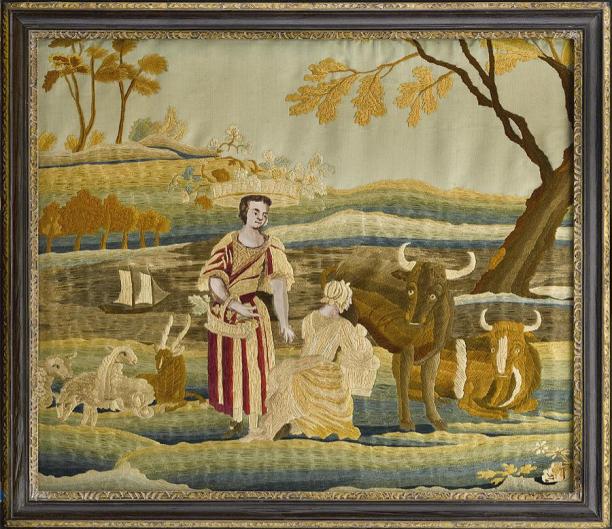By Kate Steinway for Your Public Media
In 1754, eleven-year-old Faith Trumbull (1743–1775), the daughter of Governor Jonathan Trumbull of Lebanon, Connecticut, was sent to boarding school in Boston. In the 1750s, formal education for girls was a luxury, and only the most educated and well-off families could afford that experience for their daughters. At school in Boston, Faith practiced reading, writing, arithmetic, and classical languages, along with drawing, painting, sewing, and embroidery. She learned art by copying elements from Old Master prints. For example, elements borrowed from a Dutch print are easy to see in her needlework picture of a milking scene, but Faith changed a few details—the barefoot peasant woman from the print wears fashionable black, buckled shoes in Faith’s picture, and her peasant dress has become a shimmering gown in red and gold.
Faith’s needleworks include every element we associate with pictorial art—people, animals, landscape features, color, texture, light, shadow, and perspective—but she achieved the effects using silk and thread (with some painted areas). There was very little other representational art in Connecticut in this period when professional painting did not exist in the US. Faith’s younger brother John became one of the most celebrated 18th-century American artists, but he was just an infant when Faith created her needlework pictures. These pictures hung in the Trumbull family’s house, glimmering and gleaming and full of fascinating detail. John later recalled: “These wonders were hung in my mother’s parlor, and were among the first objects that caught my infant eye. I endeavored to imitate them.”
Kate Steinway formerly the Executive Director of the Connecticut Historical Society in Hartford.
© Connecticut Public Broadcasting Network and Connecticut Historical Society. All rights reserved. This article originally appeared on Your Public Media.
Note: ConnecticutHistory.org does not edit content originally published on another platform and therefore does not update any instances of outdated content or language.








